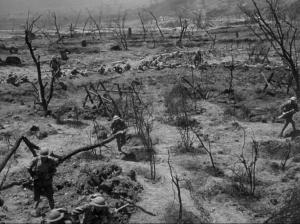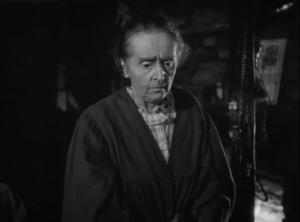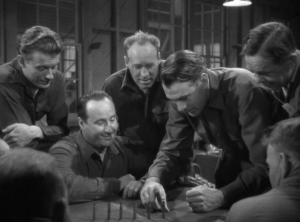[Editor’s Note: Memorial Day is Monday, May 31st, but we’re posting this week’s Classic Movie Obsession now because Turner Classic Movies will be airing Howard Hawks’ Sergeant York on Friday, May 28th at 2:30pm Pacific Time/5:30pm Eastern Time.]
By Jennifer Baldwin. Director Howard Hawks is a favorite among film critics and students of auteur theory. His fans include critics Robin Wood and Andrew Sarris, the Cahiers du Cinema crowd, and even Quentin Tarantino. I’m a big fan too.
Much has been written and said about Hawks, about his great films, about how he could work in every genre. But there’s one major Hawks film that doesn’t get much ink spilled over it; it’s the one major Hawks film that always seems to get ignored by the film critics and fans.
That film is SERGEANT YORK. Why are critics and Hawks experts so reluctant to discuss this classic biographical film about one of America’s greatest war heroes? It’s a movie anchored by the performance of a major movie star in Gary Cooper. It’s a rousing war movie. It includes many of the classic Hawksian themes. It’s beautifully shot. So what’s the deal, critics? Why no love for YORK when you’ve got plenty of words to write about HATARI!?
Two words: God. Country.
Critics avoid YORK like the plague because the film has been slapped with that wartime “propaganda” label and that’s all it needs to be effectively silenced as a work of art and an important film in the Hawks oeuvre.
Not that I’ve taken a poll or anything, but life experience tells me that most critics are left-of-center politically and that for them the subjects of Christianity and patriotism are sticky issues. A film that’s unabashedly pro-Christianity and pro-American patriotism doesn’t appeal to the majority of Hawks’ critical champions. We all tend to write about the movies that excite us and for most critics, a movie that wears its Christian patriotic heart on its sleeve is not something that appeals.
Which is a shame, because as a Hawks fan myself and a huge fan of SERGEANT YORK, I find there’s not enough written about the film. Seeing as it’s Memorial Day weekend and SERGEANT YORK is playing on TCM on Friday, May 28 at 2:30 PM PT/5:30 PM EST, I figured I’d give YORK its fair shake and make it my Classic Cinema Obsession of the Week.
A critic like David Boxwell can claim Hawks’ films “created a remarkably consistent popular body of work which promised freedom from constraints posed by organized religion, traditional family structures, and the vicissitudes of history and politics, or even nationalistic myth-making,” but this effectively leaves out SERGEANT YORK. YORK ruins the thesis, so it must be ignored. It was just Hawks working for hire, just another studio assignment and not one of his “personal” films. Or so the liberal Hawks fan would like us to believe.
But Hawks never approached YORK that way and never denigrated it as some kind of impersonal work-for-hire job. Hawks’s greatest strength was his ability to shoot his films in service to the story and characters. He was interested in telling great stories and I think YORK was as good a story as any for Hawks. And it was as much about the promise of freedom as any of Hawks’s other works.
And frankly, instead of being rah-rah American war propaganda, SERGEANT YORK was really more of a political-activist movie. The film was made before the attack on Pearl Harbor. It’s producer Jesse L. Lasky and the real life Alvin York wanted the film made as a way to stir Americans out of their complacency and isolationism. It was an activist film meant to agitate, not just some comforting pap for a wartime audience.
What critics miss when they ignore YORK is the way Hawks uses his patented “straight forward” style to mythologize an American hero and create the idealized “American Man” – all done with Hawksian realism and naturalism. Hawks creates a powerful, national mythic figure by telling York’s story through realistic and naturalistic filmmaking.
Hawks’s tendency to shoot things “as we would see them” and his avoidance of cinematic tricks and self-conscious camera movements allows him to mythologize and idealize York without making the audience feel manipulated.
We watch York’s religious conversion, his decision to fight in the war despite his pacifism, and his eventual heroics on the battlefield and none of it feels false or theatrical. Hawks gives us the events of York’s life and somehow makes them seem both epic and understated. This is a testament to the real-life York, who was a humble man who hated killing and only did so in order to save lives. York’s life was epic and yet the man himself was filled with humility.
This is Hawks filmmaking at its best: working in service of the story and the character, creating a national myth with understatement and naturalism – never with cloying bombast or sensationalism. Alvin York becomes the ideal American man and hero but it never feels false because in Hawks’s hands, we sense the realness of this man and this life in every shot. And at the center of the film is York – a man who embodies true American freedom.
There are three main sequences in the film that illustrate how Hawks creates this mythic American Hero through realism and naturalism. The first is the sequence in which York has his conversion to Christianity. The second is when York decides to fight for his country despite his pacifism. And the third is the sequence during the war when York kills twenty German soldiers and captures dozens more, eventually earning him his many medals and military honors (including the Medal of Honor).
These sequences not only exemplify the Hawksian style but also the Hawksian themes of professionalism, man’s integration into his community, and the camaraderie between groups of men (though in the case of SERGEANT YORK, this camaraderie isn’t just between a small band of men but between one man and all of his fellow citizens – a kind of band of brothers but on a massive, national scale). And unifying all of these themes is the idea of freedom – that man cannot be a professional or choose to associate with whomever he wishes or uphold the values of his group without basic liberty.
Watch the sequence where York (played by Gary Cooper), off to hurt and maybe kill a rival farmer, has his gun struck by lightning and in turn has a religious conversion.
Hawks is famous for using close-ups sparingly. Notice the quick cut to the smoking rifle. One of the most self-consciously “filmy” parts of the film, it is Hawks’ way of signifying the importance of what has just happened.
But also notice that once York enters the church looking for salvation, Hawks forgoes use of non-diegetic music (i.e.: outside orchestral music on the soundtrack). The only thing we hear is the singing of the congregation. Also, the shots are almost all medium to medium-wide shots of York amongst the congregants. This is York being welcomed into the religious community (going from loner to joiner, basically) and Hawks highlights the social aspects of the conversion.
Whereas in other canonical Hawks films there is an emphasis on the camaraderie between males, in SERGEANT YORK Hawks emphasizes the importance of camaraderie on three different levels: camaraderie with community/family (specifically on a religious level); camaraderie with fellow soldiers (a band of brothers, so to speak); and camaraderie with all of his fellow citizens (specifically spelled out in the “Render Unto Caesar” scene).
Watch the famous “Render Unto Caesar” scene, where York has another “conversion,” this time from pacifist to warrior, where he reconciles his religious faith with his patriotic duties.
Again, Hawks uses key close-ups to emphasize importance. This scene more than any other in the film feels “mythic” and it’s Hawks at his most “theatrical” and conventionally dramatic (especially the scene on the mountain). He uses voice-over, sweeping music, and close-up and it might all feel a little manipulative in another movie, but here it feels earned because of the straight-ahead realism and naturalism that comes before and after.
In terms of realism, look at the famous battle sequence, in which York singlehandedly kills about twenty German soldiers, cleans out a bunch of machine gun nests, and captures dozens more Germans.
These are the exploits that gave the real Alvin York his fame and military honors. This is the climax of the film. And yet Hawks doesn’t go in for cinematic emphasizing or camera tricks. No slow motion or dramatic music over the soundtrack. Everything is shot in the Hawksian style of watching things as they “really happened.”
Notice the parallels with early “shooting” scenes. Through these three different scenes Hawks shows us Alvin York as the exemplary Hawksian man: The Happy Professional. Shooting turkeys, shooting military targets, shooting Germans – it all requires the same masterful skill and professionalism from York.
And yet it all leads up to that most beautiful of scenes where Cooper, as York, with such quiet grief in his face, tells his superiors that he hated killing those men, but that he did it all to save the lives of hundreds of other people who would have been killed by the machine guns.
As the film ends, York has gone from loner and misfit to family man, Christian, soldier, and citizen – all without sacrificing the unique individuality and professionalism that made him special. He has become both our shining ideal and yet an all too real human being. He has become a hero, but a strikingly “Hawksian” hero.
SERGEANT YORK boasts a powerful (and Oscar-winning) performance from Gary Cooper. Hawks’ direction is masterful as always. The screenplay included work from John Huston. And Margaret Wycherly as York’s widowed mother will break your heart.
There’s also a very young Joan Leslie (around 16 years old at the time!) as York’s sweetheart and future wife, Gracie — Leslie’s a little green at times in her acting, but endearingly sweet nonetheless. And one of my favorite character actors, Walter Brennan, is the town preacher. In case you can’t watch it this weekend on TCM, the movie is available on a wonderful two-disc special edition DVD (watch the documentaries!).
One of the great patriotic (and religious) films to come out of classic Hollywood, a fine tribute to an American hero for this Memorial Day, SERGEANT YORK is my Classic Cinema Obsession of the Week.


















Hawks has never been fully understood by the American intelligentsia. Ms. Baldwin has provided one of the few analyses of “Sergent York” that avoids the easy pitfalls of political posturing. Bravo to Ms. Baldwin.
Thanks for the comment, Claude!
I find I’m often disappointed by critical appraisals of Hawks’s work. SERGEANT YORK is just one such case where I feel the “professional” critics have dropped the ball. I particularly hate it when the typical “women studies” types take their dour approach to Hawks’s screwball comedies — it’s like they’re trying to suck all the joy out of those films! And then they ignore fabulous Hawks comedies like BALL OF FIRE because, I guess, it doesn’t really fit into their gender-bending/subversive approach to his films.